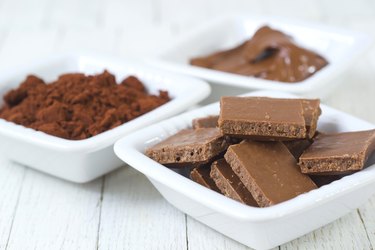
Candies and weight loss don't usually go together. Candy is almost entirely sugar, which is high in calories and lacking in nutrients — also known as empty calories. Since weight loss requires lowering your calorie intake below the calories you expend each day, eating a lot of empty calories makes it easy to miss this target. While choosing naturally sweet and nutrient-rich foods like fruit is the best choice to satisfy a sweet tooth, there are low-calorie candies you can consider when your willpower fades.
Sugar Calories and Weight Loss
Video of the Day
Consider the calorie content of some popular candies: butterscotch candies contain 111 calories per ounce, jelly beans have 109 calories per ounce and just four Twizzlers have 157 calories. This small amount of candy can make up more than 12 percent of the 1,200- to 1,500-calorie diet that the National Heart, Lung, and Blood Institute says can help most women lose weight. If you're getting more than 10 percent of your calories from sugar each day, it will be hard to meet your nutrient needs without going over your calorie goals.
Video of the Day
Sugar Hampers Weight Loss
Candy may temporarily satisfy a craving, but it's not going to provide long-lasting satiety. In fact, eating sugar can actually make you want more sugar, because it activates the pleasure and reward centers in the brain. This reduces the ability of the executive center — in charge of resisting cravings and urges — to do its job, according to a 2016 review in Diabetes.
And yet another effect of sugar that will interfere with your weight loss goals is its impact on blood sugar. Straight sugar is immediately absorbed into your bloodstream, causing an immediate rush of energy — a "sugar high." Your blood sugar quickly drops, which can lead to a craving for more sugar. It's not just a simple candy; it's part of a vicious cycle that can lead to more and more sugar consumption, weight gain and even diabetes.
Read more: Increased Blood Sugar & Weight Gain
Low Calorie and Sugar Free
The best "candy" to eat on a diet is all-natural fruit — aka nature's candy. But everyone wants to indulge occasionally. When you do indulge, choosing sugar-free candies will help you stay on track with your weight-loss goals. Candies made with sugar alcohols, such as xylitol, mannitol and sorbitol, contain no calories and have negligible effects on blood sugar. They're not without their downsides, though; Cleveland Clinic reports that sugar alcohols can cause bloating, gas, abdominal pain and diarrhea.
Sugar free doesn't mean healthy. Even sugar-free candies may contain other sources of simple carbohydrates that affect blood sugar, and they may be high in unhealthy fats such as trans fats. Read the labels and pay attention to the serving size. Sugar free doesn't mean it's OK to eat unlimited amounts.
Some research also shows that nonnutritive synthetic sugars, such as sucralose, may cause cravings and stimulate appetite the same way regular sugar does. A 2016 study in Cell Metabolism concluded that chronic consumption of sucralose increases the motivation to eat, leading to a potential calorie imbalance and weight gain.
Read more: Negative Effects of Artificial Sweeteners
Better Sweets Options
Whenever possible, it's a good idea to just avoid candies altogether. The less sugar you eat, the less sugar you'll crave. Fresh berries are sweet, and although they still contain sugar, its effects are mitigated by their fiber content, which slows the absorption of sugar into your bloodstream. They're also a rich source of vitamins, minerals and antioxidants.
Dark chocolate is another option for satisfying your sweet tooth. It's still high in calories, with 150 to 170 calories per ounce, but it contains antioxidant flavanols and minerals that boost your health. Its fat content can dampen the effects of sugar on blood sugar and provide longer-lasting satiety than jelly beans, licorice twists or even milk chocolate, which is higher in sugar than dark chocolate. Look for varieties with at least 70 percent cocoa content and stick to a 1-ounce serving once a day.
Read more: Benefits and Risks of 72% Dark Chocolate
- USDA: Basic Report: 19070, Candies, Butterscotch
- USDA: Basic Report: 19108, Candies, Jellybeans
- USDA: Basic Report: 19112, Candies, Twizzlers Strawberry Twists Candy
- NIH: National Heart, Lung and Blood Institite: Healthy Eating Plan
- Diabetes: Is Sugar Addictive?
- Harvard T.H. Chan School of Public Health: Carbohydrates and Blood Sugar
- University Health News: Do You Bolt Awake at 3 a.m.? Low Blood Sugar Symptoms May Be to Blame
- Cleveland Clinic: Is Sugar-Free Candy the Best Choice If You Have Diabetes?
- Cell Metabolism: Sucralose Promotes Food Intake Through NPY and a Neuronal Fasting Response
- Nutrients: Effects of Dietary Fiber and Its Components on Metabolic Health
- Harvard T.H. Chan School of Public Health: Dark Chocolate
- Spoon University: Dark Chocolate vs. Milk Chocolate: Which Is Better for You?